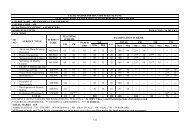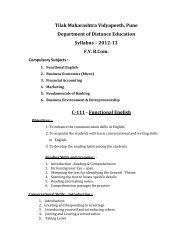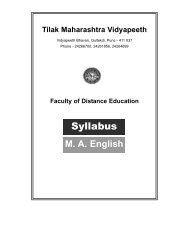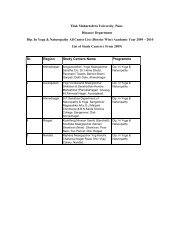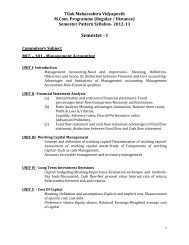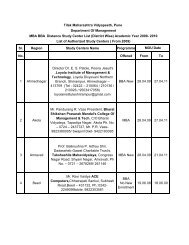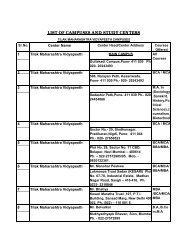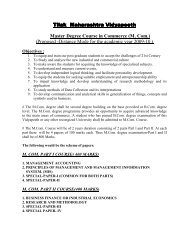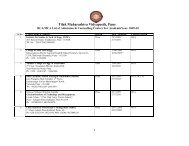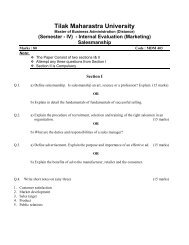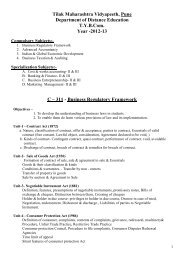Sixth Semester - Curriculam - Tilak Maharashtra Vidyapeeth
Sixth Semester - Curriculam - Tilak Maharashtra Vidyapeeth
Sixth Semester - Curriculam - Tilak Maharashtra Vidyapeeth
You also want an ePaper? Increase the reach of your titles
YUMPU automatically turns print PDFs into web optimized ePapers that Google loves.
TILAK MAHARASHTRA VIDYAPEETH,PUNE<br />
TEACHING AND EXAMINATION SCHEME FOR DIPLOMA COURSE<br />
COURSE NAME : DIPLOMA IN ELECTRONICS AND TELECOMMUNICATION ENGINEERING<br />
COURSE CODE : ET<br />
DURATION OF COURSE:6 SEMESTERS<br />
SEMESTER : SIXTH DURATION: 16 WEEKS<br />
FULL TIME<br />
SR.<br />
NO.<br />
SUBJECT<br />
CODE<br />
TEACHING<br />
SCHEME<br />
EXAMINATION SCHEME<br />
SUBJECT TITLE<br />
TOTAL PR<br />
TW<br />
PAPER TH<br />
OR<br />
TH PR<br />
INT<br />
HRS<br />
Max Min Max Min Max Min Max Min Max Min<br />
1<br />
Entrepreneurship<br />
Development (E.D.)<br />
ET6001 01 -- -- -- -- -- -- -- -- -- -- -- 50* 20<br />
2 Control Systems ET6002 04 04 03 80 32 20 100 40 -- -- 25** 10 25* 10<br />
Advance<br />
3 Communication ET6003 04 02 03 80 32 20 100 40 -- -- 25** 10 25* 10<br />
Systems<br />
4 Industrial Project ET6004 -- 06 -- -- -- -- -- -- -- -- 50** 20 50* 20<br />
5<br />
Professional<br />
Practices-V<br />
ET6005 -- 02*** -- -- -- -- -- -- -- -- -- -- 50* 20<br />
Elective- I (Any One)<br />
6<br />
Mobile<br />
Communication<br />
ET6006 04 02 03 80 32 20 100 40 -- -- 25** 10 -- --<br />
6 VLSI Design ET6007 04 02 03 80 32 20 100 40 -- -- 25** 10 -- --<br />
Elective-II (Any One)<br />
7 Embedded Systems ET6008 04 02 03 80 32 20 100 40 -- -- 25** 10 25* 10<br />
7 Telematics ET6009 04 02 03 80 32 20 100 40 -- -- 25** 10 25* 10<br />
TOTAL 17 18 -- 320 -- 80 400 -- -- -- 150 -- 225 --<br />
STUDENT CONTACT HOURS PER WEEK (FORMAL TEACHING): 35 HRS: Theory and practical Periods of 60 minutes each.<br />
* - INTERNAL ASSESSMENT , ** - EXTERNAL ASSESSMENT, ***-TUTORIAL<br />
TOTAL MARKS – 775<br />
ABBREVIATIONS : TH – THEORY , PR – PRACTICALS , OR –ORAL, TW – TERMWORK ,INT-INTERNAL<br />
All Practical, Orals & Term work assessments are to be done as per the prevailing curriculum implementation & assessment norms.<br />
149
COURSE NAME : ELECTRONICS & TELECOMMUNICATION<br />
ENGINEERING<br />
COURSE CODE<br />
SEMESTER<br />
: ET<br />
: SIXTH<br />
SUBJECT TITLE : ENTREPRENEURSHIP DEVELOPMENT<br />
SUBJECT CODE : ET6001<br />
TEACHING AND EXAMINATION SCHEME:<br />
Teaching Scheme<br />
TH<br />
PR<br />
PAPER<br />
HRS<br />
Examination Scheme<br />
TH INT PR OR TW TOTAL<br />
01 -- -- -- -- -- -- 50* 50<br />
Prerequisites: The student must know the following concepts:<br />
1. Awareness of business functions like production, purchase, sales and marketing.<br />
2. Awareness of need for personal and human qualities like discipline, inquisitiveness,<br />
leadership, drives etc.<br />
Objectives: The student will be able to<br />
1. Indentify entrepreneurship opportunity.<br />
2. Acquire entrepreneurial values and attitude.<br />
3. Use the information to prepare project report for business venture.<br />
4. Develop awareness about enterprise management.<br />
150
Subject Title: ENTREPRENEURSHIP DEVELOPMENT<br />
Subject Code: ET6001<br />
Contents: Theory<br />
Unit Name of the Topic Hours<br />
01 ENTREPRENEURSHIP, CREATIVITY & OPPORTUNITIES 03<br />
Concept, Classification & Characteristics of Entrepreneur Creativity<br />
and Risk taking. Concept of Creativity & Qualities of Creative<br />
person. Risk Situation, Types of risk & risk takers. Business<br />
Reforms. Process of Liberalization. Reform Policies. Impact of<br />
Liberalization. Emerging high growth areas. Business Idea Methods<br />
and techniques to generate business idea. Transforming Ideas in to<br />
opportunities transformation involves Assessment of idea &<br />
Feasibility of opportunity. SWOT Analysis.<br />
02 INFORMATION AND SUPPORT SYSTEMS<br />
03<br />
Information Needed and Their Sources. Information related to<br />
project, Information related to support system, Information related to<br />
procedures and formalities. Support systems. Small Scale Business<br />
Planning, Requirements. Govt. & Institutional Agencies, Formalities<br />
Statutory Requirements and Agencies.<br />
03 MARKET ASSESSMENT<br />
02<br />
Marketing - Concept and Importance. Market Identification Survey<br />
& Key components. Market Assessment.<br />
04 BUSINESS FINANCE & ACCOUNTS BUSINESS FINANCE 03<br />
Cost of Project:<br />
1. Sources of Finance.<br />
2. Assessment of working capital.<br />
3. Product costing.<br />
4. Profitability.<br />
5. Break Even Analysis.<br />
6. Financial Ratios and Significance.<br />
Business Account:<br />
Accounting Principles & Methodology:<br />
1. Book Keeping.<br />
2. Financial Statements.<br />
3. Concept of Audit.<br />
05 BUSINESS PLAN & PROJECT REPORT<br />
03<br />
Business plan steps involved from concept to<br />
commissioning:- Activity Recourses, Time, Cost.<br />
Project Report:<br />
1. Meaning and Importance.<br />
2. Components of project report/profile (Give list).<br />
Project Appraisal:<br />
1. Meaning and definition.<br />
2. Technical, Economic feasibility.<br />
3. Cost benefits Analysis.<br />
06 ENTERPRISE MANAGEMENT AND MODERN TRENDS IN<br />
ENTERPRISE MANAGEMENT<br />
1. Essential roles of Entrepreneur in managing enterprise.<br />
2. Product Cycle: Concept and Importance.<br />
3. Probable Causes of Sickness.<br />
4. Quality Assurance: Importance of Quality, Importance of<br />
testing.<br />
02<br />
151
Assignments:<br />
E-Commerce: Concept and process.<br />
Global Entrepreneur.<br />
TOTAL 16<br />
1. Assess yourself-are you are an entrepreneur<br />
2. Prepare project report and study its feasibility.<br />
Recommended Books:<br />
Sr.<br />
Title Author Publisher<br />
No<br />
Entrepreneurship<br />
Wheeler Publisher<br />
01<br />
J.S. Saini B.S.Rathore<br />
Theory and Practice<br />
Entrepreneurship E. Gorden K.Natrajan<br />
02<br />
Himalaya Publishing.<br />
Development<br />
Preferred by Colombo<br />
Entrepreneurship<br />
TTTI, Chandigadh<br />
03<br />
TTTI, Chandigadh<br />
Development<br />
Publication.<br />
Components of Project Report:<br />
1. Project Summary (One page summary of entire project).<br />
2. Introduction (Promoters, Market Scope/ requirement).<br />
3. Project Concept & Product (Details of product).<br />
4. Promoters (Details of all Promoters- Qualifications, Experience, Financial strength).<br />
5. Manufacturing Process & Technology.<br />
6. Plant & Machinery Required.<br />
7. Location & Infrastructure required.<br />
8. Manpower (Skilled, unskilled) Raw materials, Consumables & Utilities.<br />
9. Working Capital Requirement (Assumptions, requirements).<br />
10. Market (Survey, Demand & Supply).<br />
11. Cost of Project, Source of Finance.<br />
12. Projected Profitability & Break Even Analysis.<br />
13. Conclusion.<br />
152
COURSE NAME : ELECTRONICS & TELECOMMUNICATION<br />
ENGINEERING<br />
COURSE CODE : ET<br />
SEMESTER : SIXTH<br />
SUBJECT : CONTROL SYSTEMS<br />
SUBJECT CODE : ET6002<br />
TEACHING AND EXAMINATION SCHEME:<br />
Teaching Scheme<br />
Examination Scheme<br />
TH PR<br />
PAPER<br />
HRS<br />
TH INT PR OR TW TOTAL<br />
04 04 03 80 20 -- 25** 25* 150<br />
Pre-requisites: The student must know the following concepts:<br />
1. Basics of positive and negative feedback.<br />
2. Basic principle and operation of all DC motors.<br />
3. Basics of operational amplifier.<br />
Objectives: The student will be able to<br />
1. Explain About open loop and closed loop systems.<br />
2. Explain Feedback control and transfer function.<br />
3. Explain Steady state, time response, and frequency response analysis.<br />
4. Study of stability.<br />
5. Explain Control actions of electronic controllers.<br />
6. Explain Servo system and its application.<br />
7. Explain Process control system and controllers<br />
8. Explain basics of Robotics.<br />
153
Subject Title: CONTROL SYSTEMS<br />
Subject Code: ET6002<br />
Content: Theory<br />
Unit Name of the Topic Hours Marks<br />
01 OVERVIEW OF CONTROL SYSTEM<br />
08 10<br />
System- definition & practical example. Control system –<br />
definition, and practical example. Open loop & closed loop<br />
systems - definition, block diagram, practical example, and<br />
Comparison. Laplace transforms - Significance in control<br />
system. Linear time variant and time invariant systems.<br />
Definition, developing differential equations of R-C and R-<br />
L-C electric circuits. Transfer function - definition,<br />
derivation of transfer function for close loop control system.<br />
Order of a system - definition, 0, 1, 2 order system standard<br />
equation &practical examples. Block diagram representation<br />
of a system: - need, reduction rules, problems.<br />
02 DYNAMIC ANALYSIS OF A SYSTEM<br />
08 10<br />
Dynamic analysis of measurement systems: - definition,<br />
time domain and frequency domain analysis. Time domain<br />
analysis - Transient and steady state response & steady state<br />
error. Standard test inputs - step, ramp, parabolic& impulse,<br />
Need of them, significance, and corresponding Laplace<br />
representation. Poles & zeros - definition. Analysis of first<br />
order control system for unit step input; concept of time<br />
constant Analysis of second order control system for<br />
unit step input. Concept, definition & effect of damping.<br />
Time response specifications (no derivations). Problems on<br />
time response specifications.<br />
03 STABILITY & FREQUENCY RESPONSE ANALYSIS 08 15<br />
S-plane – Introduction. Stability - stable, unstable, critically<br />
stable & conditionally stable system. Relative stability. Root<br />
locations in S-plane for stable and unstable systems, Routh's<br />
stability criterion-different cases & conditions (statement<br />
method), problems. Introduction, advantages &<br />
disadvantages of frequency response analysis; frequency<br />
response specifications, Problems.<br />
04 PROCESS CONTROL SYSTEM<br />
07 15<br />
Process control system - block diagram elements. Role of<br />
controllers in process industry. Concept of sequencing &<br />
modulating controllers. Control actions-discontinuous &<br />
continuous modes. On-off controllers, Neutral zone<br />
proportional controllers (offset, proportional band) integral<br />
& derivative controllers; Composite controllers; PI, PD, PID<br />
controllers. Control actions of electronic controllers with<br />
circuits & equations (with op amp).<br />
05 ACTUATOR<br />
Servo system -definition, block diagram. AC & DC servo<br />
systems- comparison, practical example, schematic diagram,<br />
concept. Principle Servo components: Potentiometer as error<br />
detector, Synchro as error detector, Rotary encoder, Stepper<br />
motor- variable reluctance type. Comparison of stepper<br />
motor with DC servo motor. DC servo motor- characteristic,<br />
difference from a normal DC motor. Comparison between<br />
07 10<br />
154
armature controlled and field controlled DC servo motors<br />
(no TF). AC servo motor-difference from a normal 2 phase<br />
induction motor, characteristic of AC Servo meter (no TF).<br />
06 ROBOTICS<br />
Robotics- definition, concept, classification. Functional<br />
diagram of robotics, DOF, End effectors. Application,<br />
advantages and classification of robotics.<br />
07 PLC(PROGRAMMABLE LOGIC CONTROLLER)<br />
Introduction, Programming, applications and troubleshooting<br />
04 10<br />
06 10<br />
TOTAL 48 80<br />
Practical:<br />
Skills to be developed<br />
Intellectual Skills:<br />
1. Basic knowledge of digital circuits.<br />
2. Knowledge of Microprocessors.<br />
Motor Skill:<br />
1. Testing different control based systems.<br />
2. Measurement of control parameters.<br />
List of Practicals:<br />
1. DC position control system.<br />
2. AC position control system.<br />
3. Characteristics of synchro as error detector<br />
4. Step response of R-L-C second order circuit<br />
5. Temperature controller with PI controller<br />
6. Temperature controller with PID controller.<br />
7. Study input versus output characteristics of synchro transmitter and receiver.<br />
8. Study the step response of 1 st order RR/RC circuit.<br />
9. Ladder diagram for Car Parking System using PLC (Allen Bradley).<br />
10. Ladder diagram for Traffic Light Control using PLC (Allen Bradley).<br />
11. Ladder diagram for Motor Control using PLC (Allen Bradley).<br />
155
Recommended Books:<br />
Sr. No. Title Author Publisher<br />
01 Digital Control System M. Gopal Tata McGraw-Hill<br />
02 Control system Engg<br />
J.J.Nagrath &<br />
M. Gopal<br />
-----<br />
03 Control System M.Gopal Tata McGraw-Hill<br />
04 Modern control Engg K. Ogata Tata McGraw-Hill<br />
05 Control systems Kumar<br />
06<br />
Process control instrumentation<br />
Technology<br />
C. D. Johnson ------<br />
07<br />
Programmable Logic<br />
Controller<br />
Gary Dunning ------<br />
156
COURSE NAME : ELECTRONICS & TELECOMMUNICATION<br />
ENGINEERING<br />
COURSE CODE<br />
SEMESTER<br />
: ET<br />
: SIXTH<br />
SUBJECT TITLE : ADVANCE COMMUNICATION SYSTEMS<br />
SUBJECT CODE : ET6003<br />
TEACHING AND EXAMINATION SCHEME:<br />
Teaching Scheme<br />
Examination Scheme<br />
TH PR<br />
PAPER<br />
HRS<br />
TH INT PR OR TW TOTAL<br />
04 02 03 80 20 -- 25** 25* 150<br />
Pre-requisites: The student must know the following concepts:<br />
1. Concept of transmission line.<br />
2. Electromagnetic spectrum.<br />
3. Concept of LED & LASER.<br />
4. Types of cables.<br />
Objectives: The student will be able to<br />
1. Explain waveguide, its modes of operation.<br />
2. Explain various microwave components & devices.<br />
3. Explain element of satellite communication system & its subsystems.<br />
4. Explain fiber optic communication.<br />
5. Explain concept of electronic switching exchange.<br />
157
Subject Title:ADVANCE COMMUNICATION SYSTEMS Subject Code:ET6003<br />
Contents: Theory<br />
Unit Name of the Topic Hours Marks<br />
01 WAVE GUIDE<br />
08 12<br />
Microwave Region and Band Designations. Introduction to<br />
TEM/TE/TM/HE wave designation. Comparison of wave<br />
guide with two wire transmission line. Propagation of waves<br />
in rectangular wave guide only. (Introduction to circular<br />
wave guide only). TE & TM Modes in rectangle wave guide<br />
with field pattern. Concept of dominant mode. Definition<br />
and interpretation of cut off frequency of a waveguide,<br />
guide wave length, phase velocity, group velocity (Simple<br />
Numerical).<br />
02 MICROWAVE COMPONENTS AND DEVICES 10 16<br />
Construction, working Principle & Applications of Multicavity<br />
klystron amplifier, Reflex Klystron amplifier,<br />
Travelling wave tube, Magnetron – Construction, working<br />
principle & Application. Parametric amplifier, PIN Diode &<br />
Gunn Diode. Construction, Working principle & application<br />
of H-plane Tee, E-Plane Tee, E-H Plane TEE, Multihole<br />
directional coupler, wave guide, bends, corners, Twists,<br />
circulator, Isolator.<br />
03 SATELLITE AND MOBILE COMMUNICATION 08 16<br />
Fundamentals: Basic concept of Radar, Block diagram of an<br />
elementary pulsed Radar, Duplexer concept. Concept of<br />
continuous Wave Radar, Doppler effect & Speed<br />
Measurement. Block diagram and explain the operation of<br />
MTI radar. Application of Radar, Block diagram of<br />
elements of a satellite Communication system. Brief<br />
introduction of communication and geostationary orbit and<br />
Satellite. Television and azimuth angles of a Satellite.<br />
Uplink and downlink frequencies used in satellite<br />
Communication. Definition of foot print, Altitude and<br />
angles, station keeping, look angle. Satellite subsystems,<br />
Functions of a satellite.<br />
1. Power subsystem (only concept), Solar ECLIPSE.<br />
2. Telemetry, tracking & Command.<br />
3. Altitude & Orbit Control System.<br />
4. Communication Channel subsystem (Block diagram<br />
of typical transponder).<br />
04 FIBER OPTIC COMMUNICATION<br />
08 06<br />
Light Wave Spectrum History of Fiber Optic. Advantage &<br />
disadvantages of Fiber optic communication. Applications<br />
of FOC in Industrial, Defense, Commercial Field. Block<br />
Diagram of Fiber Optic Communication.<br />
05 FIBER OPTICS & RAY THEORY<br />
Construction of Fiber Optic Cable. Fiber Characteristics &<br />
Classification. Source & its Limitations, Construction &<br />
working Principle of LED, LASER. Detector & its<br />
Limitation. Construction & working principle of Photo<br />
Diode. Splicing Techniques. Definition & Concept of<br />
Reflection, dispersion, diffraction, absorption & scattering<br />
with the help of light theory. Definition of Snell's Law,<br />
10 20<br />
158
Numerical Aperture, Acceptance angle, acceptance cone,<br />
Critical Angle (Numericals).<br />
06 TELEPHONY<br />
Electronic switching exchange, Introduction to Wireless<br />
Local Loop System, Additional services given by telephone<br />
exchange like conferencing, wakeup call, call forwarding,<br />
STD lock etc.<br />
04 10<br />
TOTAL 48 80<br />
Practical:<br />
Skills to be developed<br />
Intellectual Skills:<br />
1. Working of microwave components.<br />
2. Basics of optical fiber cable and fiber optic communication.<br />
Motor Skill:<br />
1. Testing of microwave components.<br />
2. Measurement of characteristics and losses in optical fiber cable.<br />
List of Practical: (Any 8 to be performed from 1 to 13)<br />
1. Verify the characteristics of Reflex Klystron.<br />
2. Verification of characteristics E Plane Tec.<br />
3. Verification of characteristics of Isolator.<br />
4. Verification of characteristics of Circulator.<br />
5. Indirect measurement of frequency using cavity resonator.<br />
6. Measure the coupling factor of MHD Coupler.<br />
7. Calculate the N.A for given FOC.<br />
8. Calculate the bend Loss in given FOC.<br />
9. Verify the characteristics of LASER.<br />
10. Verify the characteristics of LED.<br />
11. Verify the characteristics of Photo Diode.<br />
12. Attenuation measurement in given FOC.<br />
13. Dispersion measurement in given FOC.<br />
14. Visit Industry to see<br />
a. Use of OTDR (Demonstration).<br />
b. Use of Splicing Technique (Demonstration).<br />
159
Recommended Books:<br />
Sr. No. Title Author Publisher<br />
01 Optical Fiber Communication Keiser<br />
Tata McGraw-Hill<br />
International<br />
02 Microwave Devices and Circuits Samuel liao Prentice Hall of ndia<br />
03 Optical Fiber Communication A. Selverajan Tata McGraw-Hill<br />
04<br />
Electronic Communication<br />
System<br />
Kennedy Davis Tata McGraw-Hill<br />
05<br />
Optical Fiber Communication<br />
John Senior Prentice Hall of India<br />
06 Microwave Engineering David Pozar John Wiley and Sons<br />
07 Communication Electronics Frenzel Tata McGraw-Hill<br />
08 Electronic Communication<br />
William Prentice Hall<br />
Schweber International UK<br />
160
COURSE NAME : ELECTRONICS & TELECOMMUNICATION<br />
ENGINNERING<br />
COURSE CODE<br />
SEMESTER<br />
: ET<br />
: SIXTH<br />
SUBJECT TITLE : INDUSTRIAL PROJECTS<br />
SUBJECT CODE : ET6004<br />
TEACHING AND EXAMINATION SCHEME:<br />
Teaching Scheme<br />
Examination Scheme<br />
TH PR<br />
PAPER<br />
HRS<br />
TH INT PR OR TW TOTAL<br />
-- 06 ----- ---- ---- -- 50** 50* 100<br />
Pre-requisites: The student must know the following concepts:<br />
1. Management skills.<br />
2. Analytical skills.<br />
3. Testing skills.<br />
Objectives: The student will be able to<br />
1. Plan the work, Work in Groups, and Coordinate the work.<br />
2. Generate leadership qualities.<br />
3. Analyze the different types of Case studies.<br />
4. Develop Innovative ideas.<br />
5. Write project report.<br />
161
Subject Title: INDUSTRIAL PROJECTS<br />
Subject Code: ET6004<br />
Contents:<br />
During fifth semester students will collect information, analyse the information and select the<br />
project. They will also prepare the List of the components required, PCB design, testing<br />
Procedure, Design of the Cabinet or Box or Board as the case may be. They will also prepare a<br />
Synopsis of the project. So at sixth semester they have to execute the project. A tentative<br />
Schedule is proposed below:<br />
Proposed Schedule:<br />
Weeks<br />
Procuring components, component testing and<br />
circuit testing 02<br />
PCB making and onboard testing 06<br />
Trouble shooting and cabinet making 04<br />
Documentation 04<br />
References: Books/Magazines:<br />
Sr. No.<br />
01<br />
Industrial Automation<br />
02 Electronics for You<br />
03<br />
Electronics Projects<br />
04<br />
05<br />
06<br />
Computer World<br />
Chip<br />
Name of the Magazines<br />
Any Journal Related to Electronics/Computer/Information<br />
Technology<br />
162
COURSE NAME : ELECTRONICS & TELECOMMUNICATION<br />
ENGINEERING<br />
COURSE CODE : ET<br />
SEMESTER : SIXTH<br />
SUBJECT TITLE : PROFESSIONAL PRACTICES -V<br />
SUBJECT CODE : ET6005<br />
TEACHING AND EXAMINATION SCHEME:<br />
Teaching Scheme<br />
Examination Scheme<br />
TH TUT<br />
PAPER<br />
HRS<br />
TH INT PR OR TW TOTAL<br />
-- 02*** -- -- -- -- -- 50* 50<br />
Pre-requisite: The student must know the following concepts:<br />
1. Proficient in English.<br />
2. Good communication skills.<br />
3. Knowledge of using internet and search engine.<br />
Objectives: The student will be able to<br />
1. Acquire information from different sources and convert the same into spoken language<br />
i.e. should be able to talk on the topic.<br />
2. Prepare notes for given topic.<br />
3. Present given topic in a group discussion and also to take care of body language and<br />
personality.<br />
4. Encourage peers to share thoughts and develop group discussion.<br />
163
Subject Title: PROFESSIONAL PRACTICES-V<br />
Subject Code: ET6005<br />
Sr.NO. Activity Hours<br />
01 INDUSTRIAL VISITS (2 Visits)<br />
10<br />
Structured industrial visits be arranged and report of the same<br />
should be submitted by the individual student to form part of the<br />
term work. The industrial visits may be arranged in the<br />
following areas :<br />
1. Satellite Earth Station<br />
2. Radar Establishment.<br />
3. Mobile Telephone Switching Office.<br />
4. Any other relevant area.<br />
02 GUEST LECTURES<br />
06<br />
By professional/industrial expert to be organized from any of<br />
the following areas: ( Any 3 topics)<br />
1. Fussy logic and neural network.<br />
2. Carrier guidance and interviewing techniques.<br />
3. Self-employment.<br />
4. Any other relevant topic.<br />
5. Matlab Tool- Introduction to MATLAB & MATLAB<br />
programming.<br />
03 INFORMATION SEARCH<br />
06<br />
Students should prepare a report as a part of term work how<br />
they are searching and collecting the information regarding their<br />
final project / industrial project<br />
04 SEMINAR<br />
08<br />
Each student will deliver a seminar on some technical topic. It<br />
could on his project, a topic which will give information about<br />
new trends in technology, topic of a subject which is being<br />
taught in the sixth semester OR Any other topic.<br />
05 GROUP DISCUSSION<br />
The students should discuss in a group of six to eight students<br />
and write a brief report on the same as a part of term work. The<br />
faculty members may select the topic of group discussions.<br />
Some of the suggested topics are Advance technology Boon or<br />
Curse or Any other topic.<br />
06<br />
TOTAL 36<br />
164
COURSE NAME :<br />
ELECTRONICS & TELECOMMUNICATION<br />
ENGINEERING<br />
COURSE CODE<br />
SEMESTER<br />
: ET<br />
: SIXTH<br />
SUBJECT TITLE : MOBILE COMMUNICATION<br />
(ELECTIVE-I)<br />
SUBJECT CODE : ET6006<br />
TEACHING AND EXAMINATION SCHEME:<br />
Teaching Scheme<br />
Examination Scheme<br />
TH PR<br />
PAPER<br />
HRS<br />
TH INT PR OR TW TOTAL<br />
04 02 03 80 20 -- 25** -- 125<br />
Pre-requisites: The student must know the following concepts:<br />
1. Basics of Digital communication.<br />
2. Concept of Electromagnetic Spectrum.<br />
3. Concept of EM wave propagation.<br />
4. Concept of basic antennas.<br />
5. Basics of mobile operation.<br />
Objectives: The student will be able to<br />
1. Compare operations of different mobile communication systems.<br />
2. Understand operation of mobile unit.<br />
3. Describe different cellular concept.<br />
4. Draw and explain cellular system architecture.<br />
5. Describe coverage and capacity in cellular system.<br />
6. Describe CDMA architecture.<br />
7. Describe GSM architecture.<br />
8. Compare GSM and CDMA architecture.<br />
9. Explain call processing in CDMA and GSM.<br />
10. Explain different mobile generations.<br />
165
Subject Title: MOBILE COMMUNICATION (ELECTIVE-I)<br />
Subject Code: ET6006<br />
Contents: Theory<br />
Unit no Name of the Topic Hours Marks<br />
01 INTRODUCTION TO WIRELESS COMMUNICATION 08 15<br />
SYSTEM<br />
Evolution of mobile radio communication, Mobile radio system<br />
around the world. (Such as AMPS, N-AMPS, IS-95, GSM),<br />
Definition of base station, control channel, forward channel etc.<br />
Examples of wireless communication system such as paging<br />
system, cordless telephone system, cellular telephone system.<br />
Procedure of cellular telephone call.<br />
02 MOBILE UNIT<br />
10 15<br />
Block Diagram and operation of mobile unit, Block Diagram &<br />
Explanation of frequency synthesizer, Block diagram and<br />
operation of transceiver of mobile. Block diagram of Logic<br />
unit, control unit & handset.<br />
03 CELLULAR CONCEPT<br />
10 20<br />
Introduction a basic cellular system, Frequency reuse, Hand off,<br />
Type of hand off - hard hand off, soft hand off, delayed and<br />
queued hand off, Interference & system capacity, Co channel<br />
interference & system capacity, Channel planning for wireless<br />
system, Adjacent channel Interference, Power control for<br />
reducing interference, (Closed loop, Open loop) .Improving<br />
coverage and capacity in cellular system, Cell splitting,<br />
Sectoring, Repeater for range extension, Micro cell zone<br />
concept.<br />
04 DIGITAL CELLULAR MOBILE SYSTEMS<br />
10 15<br />
G.S.M system architecture, G.S.M services & features, G.S.M<br />
radio subsystems, G.S.M channel types, Message & call<br />
processing in GSM, Privacy & security in GSM, Signaling<br />
system no.7 (SS7)-performance services, CDMA digital<br />
cellular standard IS-95, IS.95 frequency & channel<br />
specification, IS-95 system architecture, IS-95 CDMA calls<br />
Processing, Security & identification in IS-95 CDMA, Features<br />
of IS-95.<br />
05 MODERN WIRELESS COMMUNICATION SYSTEM<br />
3GW-CDMA UMTS (Universal mobile Telecommunication<br />
system, 3G CDMA 2000, 3G- TD-SCDMA (synchronous),<br />
Wireless local loop & LMDS (local multipoint distribution),<br />
IMT 2000.<br />
10 15<br />
TOTAL 48 80<br />
166
Practical:<br />
Skills to be developed<br />
Intellectual Skill:<br />
1. Identification of different components and their use<br />
2. Interpretation of Basic communication<br />
Motor Skills:<br />
1. To follow testing procedure<br />
2. Accuracy in Observations<br />
List of Practical:( Any 12 to be performed)<br />
1. Perform installation of mobile phone.<br />
2. Observe Input / Output signal of different sections.<br />
3. Read the content of SIM card.<br />
4. To understand & perform charging of handset.<br />
5. Perform testing procedure.<br />
6. Testing of mobile handset.<br />
7. Find out different add- on accessories for cell phones (battery, charger, hands free data<br />
cable).<br />
8. Identify different sections & component of mobile unit such as (Ringer section, dialer<br />
section, receiver section etc.<br />
9. Demonstration of handoff, frequency response, cell splitting.<br />
10. Prepare report on different facilities provided by cellular company (visit).<br />
11. Prepare report on cell phone operator companies and their plan & traffic (Visit).<br />
12. Find out the specifications of different handsets provided by different companies.<br />
13. Power supply requirement, battery technology, display, phone memory, answered called<br />
memory charging time, Facilities: - STD, ISD & LIP).<br />
14. Prepare report on GSM technology, its network, GSM capability & data Services.<br />
15. Study & prepare report on cell site, distance coverage, antennas used & other<br />
components.<br />
16. Industrial visit to mobile company -GSM (Airtel , BPL).<br />
167
17. Industrial visit to CDMA mobile station (TATA Indicom, Reliance).<br />
18. Prepare report on features, services provided by different companies.<br />
Recommended Books:<br />
SR. No. Title Author Publisher<br />
01<br />
Wireless Communication<br />
Principles & Practice<br />
T.S.Rappaport Pearson Education<br />
02<br />
Mobile Cellular Tele<br />
communication<br />
William Lee Tata McGraw Hill<br />
03 Mobile Computing<br />
Asoke Talukder<br />
Roopa Yavagal<br />
Tata McGraw Hill<br />
168
COURSE NAME : ELECTRONICS & TELECOMMUNICATION<br />
ENGINEERING<br />
COURSE CODE<br />
SEMESTER<br />
: ET<br />
: SIXTH<br />
SUBJECT TITLE : VLSI DESIGN (ELECTIVE- I)<br />
SUBJECT CODE : ET6007<br />
TEACHING AND EXAMINATION SCHEME:<br />
Teaching Scheme<br />
Examination Scheme<br />
TH PR<br />
PAPER<br />
HRS<br />
TH INT PR OR TW TOTAL<br />
04 02 03 80 20 -- 25** -- 125<br />
Pre-requisites: The student must know the following concepts:<br />
1. Detailed concepts of digital electronics.<br />
2. Basic concept of MOS.<br />
3. Basic concept of testing.<br />
Objectives: The student will be able to<br />
1. Explain fundamental issues of VLSI technology.<br />
2. Explain system design strategies and their implementation using high level design<br />
language.<br />
3. Explain the principles of design verification and testing.<br />
4. Explain the fabrication and applications of CMOS subsystems<br />
169
Subject Title: VLSI DESIGN (ELECTIVE- I)<br />
Subject Code: ET6007<br />
Contents: Theory<br />
Unit Name of the Topic Hours Marks<br />
01 VERY LARGE SCALE INTEGRATION (VLSI) 06 10<br />
TECHNOLOGY<br />
CMOS Logic, Basic Gates using NMOS and PMOS<br />
Switch, Parameter measurements. VLSI and its use in<br />
electronics.<br />
02 VLSI DESIGN CONCEPTS<br />
10 10<br />
MOS circuit characterization and performance<br />
estimation. CMOS Technology- P Well process, N Well<br />
process, twin tube process. Circuit elements - Resistors<br />
and capacitors.<br />
03 FINITE STATE MACHINES (FSM)<br />
06 10<br />
Moore and Mealy machines: Implementation of circuits<br />
using Moore and Mealy machines.<br />
04 ARCHITECTURE OF ASIC AND PLD<br />
06 10<br />
CPLD -Xilinx and Atmel series architecture, Details of<br />
internal block diagram. Introduction to FPGA like<br />
Xilinx (FPGA), SPARTAN 3 series and Atmel.<br />
05 HARDWARE DESCRIPTION LANGUAGE (HDL) 07 20<br />
Features of Verilog - Entity, Architecture,<br />
Configuration, Package, Bus, Driver, Attributes,<br />
process behavioral modeling, Sequential Processing,<br />
Data types and Configurations.<br />
06 SIMULATION, TESTING AND SYNTHESIS 07 10<br />
USING VHDL<br />
Simulation Issues, Testing Issues, Synthesis Issues.<br />
07 HARDWARE MODELING EXAMPLES<br />
06 10<br />
(OPERATION & BLOCK TESTING)<br />
Different styles of modeling, Modeling simple<br />
elements, Modeling conditional operators, Modeling<br />
combinational logic, Modeling regular structure,<br />
Modeling synchronous logic<br />
TOTAL 48 80<br />
Practical:<br />
Skills to be developed<br />
Intellectual Skills:<br />
1. Program Design, Verification, Testing and Synthesis skills<br />
Motor Skills:<br />
1. FPGA Selection, system level Diagnosis.<br />
170
List of Practical:<br />
1. Design, verify, test, Synthesize basic gates using VHDL (Any Two).<br />
2. Design, verify, test, Synthesize synchronous counter using FPGA.<br />
3. Design, verify, test, Synthesize Scrolling of data on seven segment display using FPGA.<br />
4. Interface ADC-DAC using FPGA.<br />
5. Generation of Ramp using DAC using FPGA.<br />
6. Temperature sensing using ADC-DAC using FPGA.<br />
7. Stepper motor controller using FPGA.<br />
8. 8:1 multiplexer using FPGA.<br />
9. 2:4 Decoder using FPGA.<br />
10. 8:3 Encoder using FPGA.<br />
List of Practice Oriented Projects (Any One):<br />
11. 4 bit ALU using FPGA.<br />
12. LCD controller using FPGA.<br />
13. Lift controller using FPGA.<br />
List of Equipments:<br />
Hardware using FPGA's of the Spartan-II & Vertex series from Xilinx or Atmel series.<br />
Recommended Books:<br />
Sr. No. Title Author Publisher<br />
01 Basic VLSI Design Douglas A Pucknell Prentice Hall of India<br />
Kamran Eshraghian<br />
02 VHDL Douglas Perry McGraw Hill<br />
03 Digital Design John F Wakerly Prentice Hall of India<br />
171
COURSE NAME : ELECTRONICS & TELECOMMUNICATION<br />
ENGINEERING<br />
COURSE CODE<br />
SEMESTER<br />
: ET<br />
: SIXTH<br />
SUBJECT TITLE : EMBEDDED SYSTEMS (ELECTIVE-II)<br />
SUBJECT CODE : ET6008<br />
TEACHING AND EXAMINATION SCHEME:<br />
Teaching Scheme<br />
Examination Scheme<br />
TH PR<br />
PAPER<br />
HRS<br />
TH INT PR OR TW TOTAL<br />
04 02 03 80 20 -- 25** 25* 150<br />
Pre-requisites: The students must know the following concepts:<br />
1. Architecture of 8051 Microcontroller.<br />
2. Pin diagram of 8051 Microcontroller.<br />
3. 8051 Instruction Set.<br />
4. Assembly Language Programming.<br />
5. RISC & CISC Architecture.<br />
Objectives: The students will be able to<br />
1. Describe the external peripheral devices interfacing.<br />
2. Develop device driver for various external peripheral devices.<br />
3. Develop different communication protocols.<br />
4. Explain concept and applications of embedded system.<br />
5. Design and develop different embedded applications.<br />
6. Explain RTOS implementation in embedded systems.<br />
172
Subject Title: EMBEDDED SYSTEMS (ELECTIVE-II)<br />
Subject Code: ET6008<br />
Contents: Theory<br />
Unit Name of the Topic Hours Marks<br />
01 8051 I/O PORTS & INTERRUPTS<br />
08 04<br />
8051 Parallel I/O Ports, Interrupt handling & programming.<br />
Concept of synchronous & asynchronous interrupts, ISR,<br />
Programming external hardware interrupt & Timer<br />
interrupt.<br />
02 INTRODUCTION TO COMMUNICATION<br />
12 20<br />
PROTOCOL<br />
Serial Communication - Study of SBUF, SMOD, SCON,<br />
PCON registers & programming for serial communication.<br />
Introduction of RS-232, Study of RS-232 Pinout. Serial<br />
protocols: I2C, CAN, Fire wire, USB. Introduction &<br />
Comparison Parallel protocols-PCI bus, PCI-X bus<br />
introduction & Comparison. Introduction to ARM7-TDMI.<br />
03 EMBEDDED SYSTEM<br />
06 16<br />
Introduction, different Hardware Units, advantages like<br />
Reliability, efficiency and cost, Applications. Software &<br />
Hardware development tools, IDE, Compiler, Debugger,<br />
Simulator, Emulator, In circuit Emulator (ICE), Target<br />
Board, Device Programmer, Embedded software<br />
development cycle.<br />
04 DEVICE DRIVER & INTERFACING<br />
14 20<br />
APPLICATIONS<br />
Concept of Device Driver, Interfacing of seven segment<br />
display & LCD display Interfacing diagram & pin out of<br />
LCD (Demonstration & programming in practical session<br />
only), Interfacing of Key board, ADC & DAC- interfacing<br />
diagram & programming. Interfacing of stepper motorinterfacing<br />
diagram & programming.<br />
05 RTOS & INTERPROCESS COMMUNICATION<br />
Concepts of RTOS: Requirement, Need, Specification of<br />
08 20<br />
RTOS in Embedded systems. Multitasking, Task<br />
synchronization & Mutual Exclusion, Starvation, Deadlock,<br />
Multiple Process, concept in RTOS.<br />
TOTAL 48 80<br />
Practical:<br />
Skills to be developed<br />
Intellectual skills:<br />
1. Use of programming language constructs in program implementation.<br />
2. To be able to apply different logics to solve given problem.<br />
3. To be able to write program using different implementations for the same problem<br />
4. Study different types of errors as syntax semantic, fatal, linker & logical<br />
5. Debugging of programs<br />
173
Motor skills:<br />
1. Understanding different steps to develop program such as - Problem definition, Analysis,<br />
Design of logic, Coding, Testing, Maintenance (Modifications, error corrections, making<br />
changes etc.)<br />
List of Practical :( Any 10 to be performed)<br />
Students undertaking project based on Microcontroller should perform any 8 practical from the<br />
list given. Students not undertaking Microcontroller based project should perform 9 practical in<br />
which practical number 10 & 11(Stepper Motor interfacing & ADC Interfacing) are compulsory.<br />
1. Development and execution of the program for sending data on port lines.<br />
2. Development and execution of the program for arithmetic operation and time delay.<br />
3. Development and execution of the program for input and output operation.<br />
4. Development and execution of the program for interface LEDs to particular port.<br />
5. Development and execution of the program to generate a square wave on port.<br />
6. Development and execution of the program for logical operators and data conversion.<br />
7. Development and execution of the program PWM waveform generation.<br />
8. Development and execution of the program to display "MSBTE" message on LCD 16x2.<br />
9. To write 8051 C program to send "WELCOME" on serial port continuously.<br />
10. Interface Stepper Motor to Microcontroller 8051 and development and execution of<br />
the program to run stepper motor.<br />
11. Interface ADC to Microcontroller 8051 and development and execution of the<br />
program to display digital equivalent of analog input<br />
12. Interface DAC to Microcontroller 805 and development and execution of the<br />
program to generate specified voltage.<br />
Recommended Books:<br />
Sr. No. Title Author Publisher<br />
01 Embedded Systems Raj Kamal Tata McGraw Hill<br />
02<br />
The 8051 Microcontroller And Muhammad Ali PHI<br />
03<br />
Embedded Systems<br />
Microcontrollers (Theory And<br />
Applications)<br />
04 The 8051 Microcontroller<br />
05<br />
Embedded System Design: A<br />
unified Hardware/Software<br />
Introduction<br />
Mazidi, Gillispie<br />
Ajay V Deshmukh<br />
Kenneth J. Ayala<br />
Frank Vahid,<br />
Toney Givargis<br />
Tata McGraw Hill<br />
PRI John Wiley<br />
An Embedded<br />
Software Primer<br />
Pearson Education<br />
174
COURSE NAME : ELECTRONICS & TELECOMMUNICATION<br />
ENGINEERING<br />
COURSE CODE<br />
SEMESTER<br />
: ET<br />
: SIXTH<br />
SUBJECT TITLE : TELEMATICS (ELECTIVE-II)<br />
SUBJECT CODE : ET6009<br />
TEACHING AND EXAMINATION SCHEME:<br />
Teaching Scheme<br />
Examination Scheme<br />
TH PR<br />
PAPER<br />
HRS<br />
TH INT PR OR TW TOTAL<br />
04 02 03 80 20 -- 25** 25* 150<br />
Pre-requisites: The student must know the following concepts:<br />
1. Basics of analog and digital circuits.<br />
2. Basics of communication.<br />
3. Basics of cables.<br />
Objectives: The student will be able to<br />
1. Identify different sections of telephone receiver.<br />
2. Describe operation of cordless telephone.<br />
3. Explain different digital switching system.<br />
4. Explain analog and digital services.<br />
5. Explain Principle and services provided by ISDN.<br />
6. Install EPABX system.<br />
7. Explain the operation of FAX and modem.<br />
175
Subject Title: TELEMATICS (ELECTIVE-II)<br />
Subject Code: ET6009<br />
Contents: Theory<br />
Unit Name of the Topic Hours Marks<br />
01 TELEPHONE INSTRUMENT AND SIGNALS<br />
04 10<br />
Introduction to Telephone receiver. Block diagram &<br />
operation of electronic telephone. Tones used in telephone<br />
exchange dial tones, busy tone, ring tone, number<br />
unobtainable tone. Touch tone (DTMF) Block diagram of<br />
cordless telephone system Frequency allocation.<br />
02 DIGITAL SWITCHING SYSTEM<br />
08 15<br />
Introduction, Classification of switching system.<br />
Telecommunication network - trunks, subscriber lines,<br />
Basic of switching system.- Inlets, outlets symmetric network,<br />
folded network, blocking network, non-blocking network<br />
Elements of Switching system, SPC (Stored program<br />
control)-Centralize SPC, Distributed SPC, Enhanced services,<br />
Telephone Network, Subscriber loop system-MDF,MF,FP,<br />
BF,DP,DC,DW.<br />
Switching Hierarchy routing Numbering plan- telephone<br />
number.<br />
03 ANALOG, DIGITAL SERVICES AND APPLICATIONS 08 10<br />
OF TELECOMMUNICATION<br />
( only informative treatment )<br />
Analog services - Switched, leased, local call service, Toll<br />
call services, 800 services, WATs, 900 services. Digital<br />
services- switched / 56, Digital data service (DDS), Digital<br />
signal services (DS). Digital subscriber line (DSL) - ADSL.<br />
Business applications of telecommunication. Automated teller<br />
machines (ATM).Videoconferencing Banking, Shopping<br />
Telecommuting, Distance Learning, Telemedicine.<br />
04 ISDN<br />
08 15<br />
Motivation for ISDN, Services provide by ISDN. X. 400<br />
family of standards. Architecture of ISDN. ISDN rate access<br />
interface, Primary rate access (PRI) interface. Basic rate<br />
access (BRI) interface, Message format for ISDN, ISDN<br />
address structure Broad band ISDN. Introduction to FAX,<br />
Working principle of FAX. Image processing. Data<br />
compression. Block diagram & operation of FAX machine.<br />
Introduction to Modem. Working principle of Modem. Types<br />
of Modem- Synchronous, Asynchronous, half duplex & full<br />
duplex. Block schematic of Modem. ADSL & cable Modem.<br />
05 TELEPHONE INSTRUMENT ( DTMF)<br />
04 10<br />
Tone Type, MF, Wireless Telephone, FAX, ISDN<br />
Installation. ISDN Procedure, PRZ, BRZ Line, ISDN<br />
telephone, FAX, Conferencing Internet.<br />
06 EPABX (ELECTRONIC PRIVATE AUTOMATIC<br />
08 10<br />
BUSINESS EXCHANGE)<br />
Block diagram of Signal Processing (working), Analog<br />
CMOS cross point switch. Digital TDM / PCM switch.<br />
Installation procedure for EPABX.<br />
07 EPABX<br />
Installing Procedure. Programming on Console, on terminal,<br />
on computer. Maintenance technique. Voice Over IP Phone.<br />
Wiring Diagram.<br />
08 10<br />
TOTAL 48 80<br />
176
Practical:<br />
Skills to be developed:<br />
Intellectual Skills:<br />
1. Basics of telephone system.<br />
Motor Skill:<br />
1. Testing telephone systems.<br />
2. Installation procedures.<br />
List of Practical:<br />
1. Testing and installation of fixed telephone<br />
2. Testing and installation of cordless telephone<br />
3. Visit to Telephone exchange and prepare report.<br />
4. Draw the layout of given EPABX system.<br />
5. Installation and testing of EPABX system.<br />
6. Preparation and installation of wiring layout using MDE, CT boxed box.<br />
7. Installation of FAX machine.<br />
8. Installation of MODEM.<br />
Recommended Books:<br />
Sr. No. Title Author Publisher<br />
01<br />
Telecommunication<br />
Prentice Hall of<br />
switching systems T. Vishwanathan<br />
India<br />
and networks<br />
02<br />
Communication<br />
Tata McGraw-Hill<br />
Louis E. Frenzel<br />
Electronics<br />
03<br />
Data Communication Behrouz A. Tata McGraw-Hill<br />
working<br />
Forouzan<br />
04<br />
Principle of N.N Biswas -----<br />
05<br />
Telephony<br />
Management of<br />
Telecommunication<br />
H. Carr and C.<br />
Snyder<br />
Tata McGraw-Hill<br />
177




